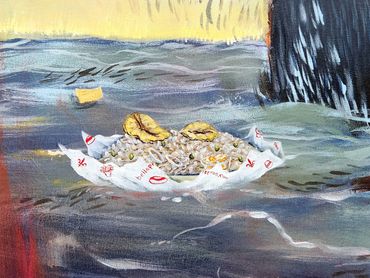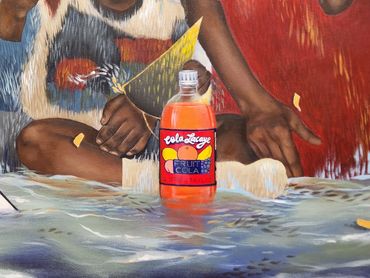Sou Wout La
1/7
Seri sa a montre eksplorasyon atis la nan dyaspora ayisyen an jan li egziste nan vil natal li Monreyal. Gras a divès mwayen transpò, penti yo gide spektatè a nan tout kwen vil la. Pandan vwayaj sa a, atis la eksprime souvni yo ak ensekirite ki lye ak idantite kiltirèl li, fè efò pou fòme yon fil komen ak jenerasyon imigran ki vin anvan li.
Sou Wout la (On the Road) follows Wendy-Alexina's daily journey through her hometown, Montreal, in her quest to fortify her relationship with her Haitian culture.
Through an excursion in various means of public transportation, the viewer explores the metropolitan area from a new perspective that reveals the physical and cultural roots instilled by the Haitian people.
To this end, this particular journey illustrates the lack of cultural belonging often felt by the children of immigrants and highlights their community of origin already present in their daily lives.
✦ ✦ ✦
Sou Wout la (Sur le Chemin) suit le voyage quotidien de Wendy-Alexina dans sa ville natale, Montréal, dans sa quête pour fortifier sa relation avec sa culture haïtienne.
À travers une excursion dans divers moyens de transport public, le spectateur explore la région métropolitaine d'une nouvelle perspective qui révèle les racines physiques et culturelles instillés par le peuple haïtien.
À cet effet, ce voyage particulier illustre le manque d'appartenance culturelle souvent ressenti par les enfants d'immigrés et fait ressortir leur communauté d'origine déjà bien présente dans leur vie quotidienne.
Gold Hibiscus
Acrylic on canvas, 5 in. × 8 in., 2022
✦ ✦ ✦
Acrylique sur toile, 5 po. × 8 po., 2022
Les dirigeants du MR-63

In this painting, Vancol stands among a crowd waiting for the subway, depicted as the first MR-63 model—a symbol of Montreal’s 1970s expansion. That decade also saw many Haitian immigrants, including Vancol’s family, whose community now plays a vital role in shaping the city’s cultural identity.
Acrylic on canvas, 50 in. × 38 in., 2022
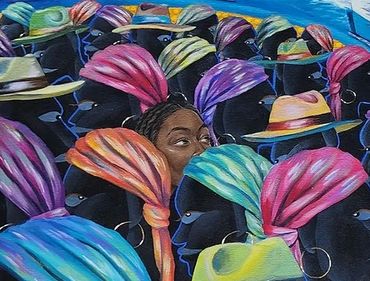


Je pars pour longtemps, mais pas pour toujours - Lucina Joseph

Superimposed on a bright, colorful background, the portraits honor the artist’s deceased family members—those who lived, shaped her path, and forged a journey between Haiti and Quebec, paving the way for the next generation.
Acrylic on canvas, 5 in. × 8 in., 2022
Je pars pour longtemps, mais pas pour toujours - Clother Fable
Acrylic on canvas, 5 in. × 8 in., 2022
✦ ✦ ✦
Acrylique sur toile, 5 po. × 8 po., 2022
Je pars pour longtemps, mais pas pour toujours - Marie Rose Saintanise Elisca
Acrylic on canvas, 5 in. × 8 in., 2022
✦ ✦ ✦
Acrylique sur toile, 5 po. × 8 po., 2022
Je pars pour longtemps, mais pas pour toujours - Elizabeth Morno
Acrylic on canvas, 5 in. × 8 in., 2022
✦ ✦ ✦
Acrylique sur toile, 5 po. × 8 po., 2022
Sous l'abribus

In this painting, Vancol depicts a bus stop where locals wait for the popular Bus 67, which runs along Saint-Michel Avenue. From the stop, viewers can spot the notable Haitian restaurant and grocery store “Pam Pi Bon,” a beloved local establishment that is also featured on the bag in the artwork.
Acrylic on canvas, 18 in. × 24 in., 2022
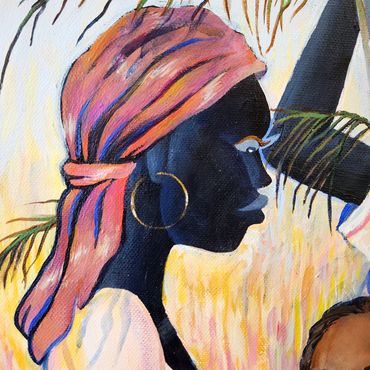


D'une frontière à l'autre

In this painting, Vancol steps off the train at Gare St-Michel at day’s end, glancing back at the familiar cityscape that signifies home. In the background appear landmarks like La Maison d’Haïti, her father’s favorite barbershop, the Orange Julep, the Five Roses building, Oratoire St-Joseph, and Méli-Mélo restaurant.
Acrylic on canvas, 36 in. × 36 in., 2022
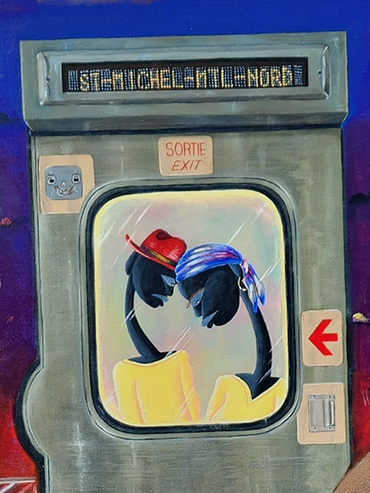
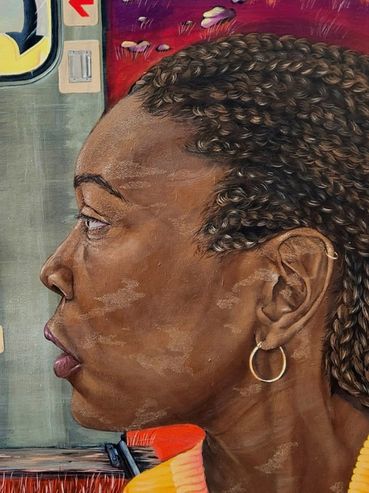

Départ imminent

In this painting, Vancol uses a simplified style to depict herself chasing a bus as part of her fitness routine. To the right, a figure carries a bag for Montreal’s Haitian nursing coalition, honoring the city’s many Haitian nurses. Iconic landmarks like the Olympic Stadium and the Biosphere frame the scene.
Acrylic on canvas, 48 in. × 36 in., 2022

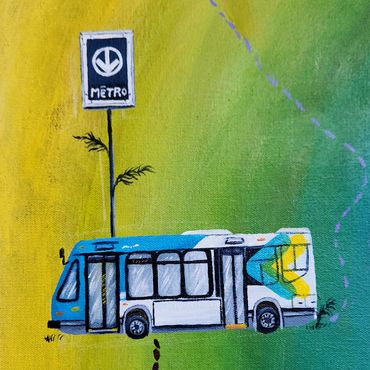

Prochain arret

In this painting, the artist rides the 470 bus, her usual route to the Côte-Vertu metro station. Outside, an ad for Montreal’s Creole theater troupe promotes the fourth Festi Teyat Kreyòl in fall 2022, set against a lush backdrop of palm trees that adds to the scene’s calm ambiance.
Acrylic on canvas, 18 in. × 24 in., 2022



Le point d’ancrage

This piece celebrates the blend of Haitian and Quebecois cultures through a vibrant birthday scene, filled with symbolic objects: a bowl of riz ak pwa with fried plantain in a Belle Province wrapper, a bottle of Kremas, a CD of the 2003 Haitian film I Love You Anne, a bottle of Cola Cola, and a figurine of Quebec’s Bonhomme Carnaval.
